The Ischia project, sponsored by the University Museum in close collaboration with the Superintendency of Antiquities of Naples, was started in autumn 1965 with a two month campaign, from September 1 to october 31; a further campaign is under way at the time of writing (spring 1966). The 1965 staff of this project consisted of Dr. Giorgio Buchner of the Superintendency of Antiquities of Naples as Director; Dr. Theresa Howard Carter of The University Museum as Assistant Director; Mr. Fritz Gehrke of Berlin as Draftsman; and Mr. Alastair Small, Scholar in Classical Studies at the British School at Rome, as Student Assistant.
On the western edge of the Gulf Naples, at a distance of eighteen miles from that city, lies the island of Ischia. Entirely of volcanic origin, and thus quite different from the limestone island of Capri on the opposite side of the Gulf, Ischia is of geologically recent formation: only at the beginning of the Quaternary Age did it rise from the sea. Innumerable volcanic eruptions have of many hot mineral springs and sources of hot steam shows that the local magma basin under the island is not yet quite extinguished.
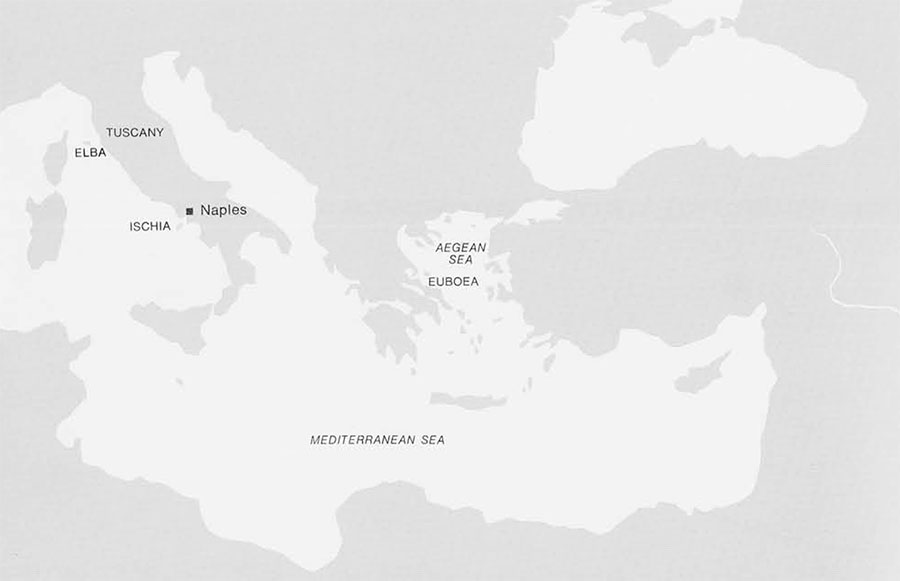
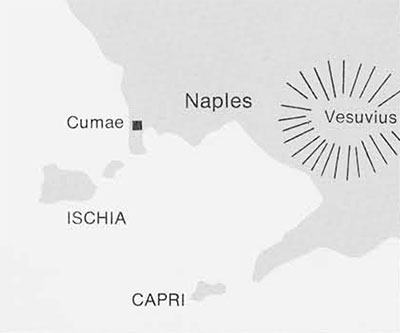
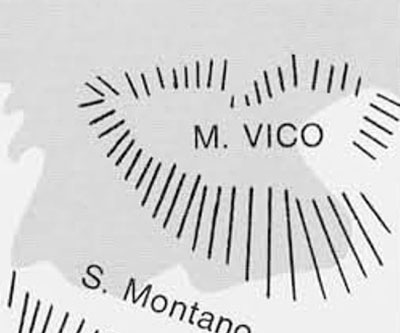
Unlike Capri and the little neighboring island of Procida, both of which preserve their Greek names in a slightly modified form, Ischia has changed its name repeatedly. In the Middle Ages it was called Insula Maior, “the Greater Island,” or simply Insula, from which the modern Ischia is derived. It was known to the Romans as Aenaria, and to the Greeks as Pithekoussai. The town and the island were synonymous, as was usual with small islands.
According to the ancient geographer Strabo, Pithekoussai was founded jointly by people from Eretria and Chalcis–the two main cities on the island of Euboea. They lived in prosperity until a number of the inhabitants abandoned the island, first because of interior discord and later because of fear of volcanic eruptions. Strabo gives no chronological statement about the foundation, yet he makes it clear that the establishment of the colony must have been before the Lelantine war which disunited the two neighboring towns of Chalcis and Eretria, that is is any case during the eighth century B.C. The same author affirms that Cumae was the oldest Greek colony in Italy and Sicily. Livy, on the other hand, states that the Chalcidians before founding Cumae on the mainland opposite established a colony on the island of Pithekoussai. Thus one might combine these two texts and deduce that a tradition existed which maintained that Pithekoussai was the oldest Greek colony in the Western Mediterranean.
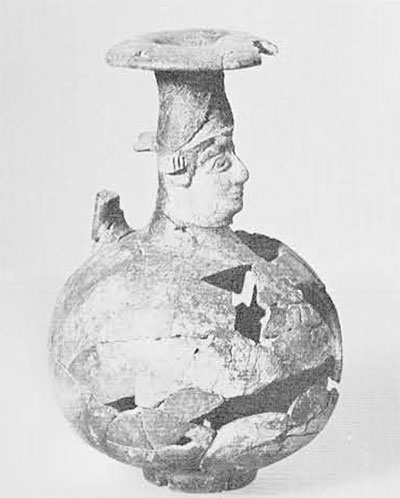
Modern archaeological research had fully confirmed the ancient age of Cumae (founded about 750 B.C.), but nothing at all was known about Pithekoussai, although the sites of the ancient town and of its cemetery were already correctly identified by a local scholar at the end of the eighteenth century as being the promontory of Monte di Vico and the underlying valley of Monte di Vico and the underlying valley of San Montano adjoining the modern village of Lacco Ameno in the northeast corner of the island.
Not until 1952 was a scientific excavation of the necropolis of San Montano begun by the present writer. By 1961, an area of approximately a thousand square meters had been excavated, yielding 730 graves. The majority of these tombs belong to the eighth and seventh centuries B.C. There were no substantial changes in the types of burials during this period. Cremation and inhumation were practiced side by side. The cremation procedure was always the same. The pyre was lit on the hearth for the burning of corpses, outside the area so far excavated, never on the site of the burial. The remains, consisting of the ashes of carbonized wood mixed with fragments of burnt human bones, pottery, and personal ornaments, were carried to the burial place and heaped on the surface. In addition, an unburnt wine jug was often placed on the heap of ashes. The whole was then concealed beneath a tumulus of rough stones, with a diameter between 1.50 and 4.50 meters, in a fashion unfamiliar in Greek burials except in parts of East Greece. All the more interesting to note is the close correspondence of the Pithecusan tumuli with the tombs described by Homer, particularly the tomb of Patroclus (Iliad XXIII, 255 f.), naturally taking into consideration that Patroclus’ tomb was that of a hero, and these are only the tombs of ordinary humble mortals. The function of the unburnt jug as well can be explained by reference to Homer (Iliad, XXIII, 250) as the jug used to quench with wine the embers of the funeral pyre. The inhumation burials consist for the most part of a trench containing a wooden casket. Usually some large rough stones were put on the cover of the coffin, possibly with the intention of preventing the ghost of the deceased from returning and doing har. The infant burials are very often in wine amphorae, with or without additional packing of stones.

Just as there is no marked difference in tomb types during the eighth, seventh, and beginning of the sixth century, there is no substantial difference in the sort of grave goods in this period. Practically without exception, even in tombs of quite small children, one finds a wine jug and a drinking vessel. Likewise usually found, and often in quantity are the little perfume or ointment flasks, aryballoi of various kinds or similar small closed vases. Other shapes of vases are less frequent. There are scarcely any weapons. Tools too are rather rare: some iron knives, axes, and chisels. Of women’s tools, spinning whorls and a small bronze sewing needle have been discovered. With regard to personal ornaments, fibulae, that is safety pins used to hold the garments together, are found in the majority of the tombs, generally placed symmetrically on the shoulders. Other ornaments are spiralled earrings and bracelets and rings of silver or bronze. The amulets are particularly interesting; they consist of Oriental scarabs and scaraboid seals found in position on the breast, that is, they had been suspended around the neck.
The expectations with which we started digging in the cemetery of Pithekoussai have been fulfilled to a high degree. Was Ischia really the oldest Greek settlement in the Western Mediterranean? And–if this should turn out true–what was the motive which induced the Greeks of Euboea to commence their western colonization at Pithekoussai and Cumae which to the end remained their most distant settlements in Italy? There is scarcely any doubt that the finds have answered the first question in the affirmative. The site has produced a great amount of Greek pottery of the eighth century B.C., both original specimens imported from Greece and imitations locally made by the settlers with the potter’s clay available on the island. Some of this is older than the oldest pottery found in the Greek tombs at Cumae or at any other Greek colony in Italy and Sicily, and dates most probably from the years before the middle of the eighth century. The answer to the second question–the reasons for the foundation–though it seemed already possible to deduce it from the finds in the cemetery, could be materially proven by the most recent discoveries on the acropolis made during the excavations sponsored by the University Museum, as we shall see below.
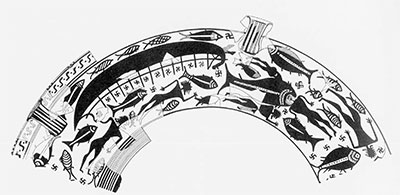
In general, what makes the finds form the early graves of Pithekoussai particularly interesting is the astonishing wealth of objects imported from many different and far distant regions, a circumstance otherwise by no means familiar in Greek cemeteries. Besides the pottery of local manufacture which mostly imitates the shapes and decorations of the Protocorinthian vases, there is much original Protocorinthian pottery, a usual feature, this carefully shaped and neatly decorated ware having been very popular and imported everywhere in Greek lands. But moreover we find Euboean pottery imported from the mother cities, and other Geometric pottery from various places in Greece, not all as yet identified; among these are vases from Athens, Rhodes, possibly the Cycladic islands and Argos. Other imports come from Italy itself; for example a small Etruscan amphora of a popular type decorated with incised double spirals, and vases from Apulia painted in the indigenous Geometric style. Most significant is the frequency of objects imported from the Near East and Egypt. A little ointment flask of Syrian origin, here reproduced for the first time, has its neck in the form of a female head. Two more absolutely identical specimens are known, though much more fragmentary than ours, one found at Tarsus, the other in the Neo-Hittite town of Zinjirli. Other vases are of Phoenician origin.
Numerous scaraboid seals, thirty-nine to date to be exact, were found in the eighth century graves, and were worn as amulets. All belong to the same class of a very characteristic style, known as the “Lyre Player group” from one of the frequently recurrent motifs. The study of their incised devices shows that they belong to a marginal zone of the Neo-Hittite cultural sphere. The center of production of these seals, though not yet accurately identified, is doubtless in the area of Cilicia or North Syria. Because of their vast distribution in Greek lands, they represent a precious trace element for the commercial relations with the Near East. (They are found at Rhodes, Chios, Crete, PAros, Delos, Sparta, Corinth, Aegina, Sunion, Delphi, Thebes, Ithaca.) In Italy, apart from Ischia where we have the greatest number ever found at a single site, only one specimen from Cumae and four others from Etruria are known so far.
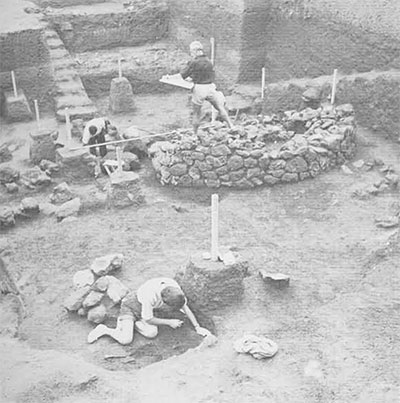
Side by side with the scaraboid seals the Greeks of Pithekoussai used to wear scarabs as amulets. To date we have found about sixty–certainly the most numerous series so far discovered in a Greek cemetery, with the exception only of Cumae. The majority are genuine Egyptian, from the Delta region, many inscribed with the invocations to the god Amon. As a rule these scarabs of late dynasties cannot be dated more precisely, save in those rather rare cases in which they bear the name of a contemporary Pharaoh. We had the fortune to find such a scarab, inscribed with the name of Pharaoh Bocchoris (Wahkare), sovereign of the 24th Dynasty who reigned from 720 to 715 B.C. The tomb in which it was found belongs to a baby of two and a half to three years of age. Fortunately it is moderately rich, and contains some characteristic pottery. Besides a local wine jug there are vases imported from five different centers of production, among them four Protocorinthian vases of characteristic types. Thus the Pithecusan Bocchoris tomb will give a “peg” date for the chronology of the Greek pottery of the eighth-seventh century B.C., and one that is specially important since it is independent of the traditional dates of the foundations of Western Greek colonies, upon which this chronology is mainly based.
The inhabitants of Pithekoussai, in the eighth century B.C., were by no means backwoodsmen, though–it is good to visualize this fact–theirs was an outpost colonial town located in what was at that time for the Greeks the utmost Far West of the civilized world. Two uncommon finds from the necropolis show that they were quite “up to date,” in regard to both art and belles-lettrs. Of local manufacture is a vase of Late Geometric style, datable to about the end of the eighth century, showing the unusual scene of a shipwreck. Of this already well known piece, we publish here for the first time a drawing which includes some new fragments and some minor corrections. (This vase was not found in a grave, but reconstructed from sporadic fragments scattered over an area of about one hundred square meters.) On one side of the vase the great ship has capsized, and two sailors are depicted among the fish beneath. On the other side an enormous fish devours a man, whose head is already within the fish’s mouth; a multitude of other fish and shipwrecked sailors are in the field. This lively picture can quite well bear companion with the best works of Greek Late Geometric figure painting.
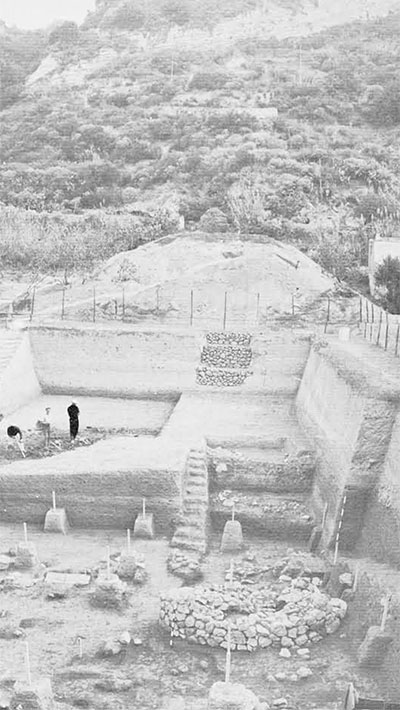
Even more important is the other vase, a Geometric cup of Rhodian manufacture, discovered in a cremation grave: it bears an incised metrical inscription in three lines, of which the second and the third are good epic hexameters. The verses are a challenge to Nestor’s famous cup of which Homer sang. They read, in John Boardman’s translation, “Nestor had a most drinkworthy cup, but whoever drinks of mine will straightaway be smitten with desire of fair-crowned Aphrodite.” The graffito runs from right to left like all the oldest Greek inscriptions, and shows the characteristics of the Chalcidian alphabet. The inscription was therefore written in Pithekoussai. The chronological indications provided both by the other vases of the grave group and by the horizontal stratigraphy agree with the assignment of the vase and of its inscription to the years around about 730 B.C. Hence the inscription is among the oldest known documents of Greek script and represents the first piece of poetry of Homeric times preserved in contemporary writing.
All the finds we have mentioned belong to the eighth century B.C. In the tombs of the seventh and later centuries the grave goods do not differ from those familiar from the excavations of other Greek colonies in Italy and Sicily of these centuries. During a period that was short, but nonetheless crucial in the formation of our Western civilization, namely the eighth century B.C., Pithekoussai was an important center where the maritime traffic from Greece, the Aegean islands, Syria, and Egypt converged, and made it the most advanced Greek port for trade with the Etruscans of Central Italy.
Thus the excavation in the cemetery of the San Montano valley had already revealed the outstanding interest of this site for the better knowledge of the period of the earliest Greek colonization of Italy, which brought the indigenous Italic population and the Etruscans for the first time in contact with the superior Hellenic civilization. However, the researches had been carried out so far only on a limited scale. The thousand square meters of the necropolis explored represent indeed only less than two percent of its whole area; still completely untouched was the site of the acropolis, except for a surface survey and a couple of small sondages. Hence the decision of the University Museum to start, in close cooperation with the Superintendency of Antiquities of Naples, a larger scale project of exploration on Ischia appeared most opportune and most likely to be rewarding.
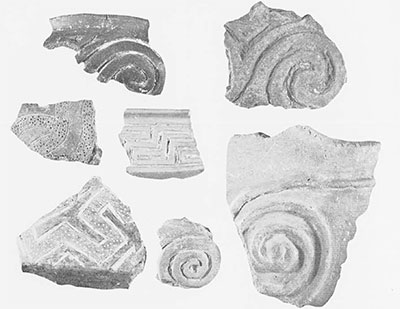

This joint project was started in the autumn of 1965 with a two months’ campaign, both in the necropolis and on the acropolis. In the necropolis a 45-foot wide transversal cut through the whole valley of San Montano was started. For the present a length of ninety feet, that is, half of the valley’s width at its narrowest point, has been uncovered. Owing to the thickness of the covering earth, only the last two weeks of the campaign could be devoted to the actual opening of graves. In the spring of 1966 the work is being resumed. The greater part of some forty tombs which could be dug before closing the 1965 season belong again to the eighth century. Among the finds some are unparalleled in the previously excavated tombs, such as a big Apulian jar painted in the indigenous Geometric style which was used to contain the body of an infant. The greatest part of the uncovered area had to be left and will be explored in the spring and autumn campaigns of 1966, whilst the other half of the valley’s width will probably be excavated in 1967.
At the same time, the first major excavation on the promontory of Monte di Vico, the site of the Greek town, was carried out. On its east slope an ancient dump filling a channel eroded by the rainwater was discovered and dug. It contained a huge quantity of potsherds and other material ranging from the Bronze Age to the second century B.C.. A selection of fine specimens of the typical incised pottery of the so-called Apennine Culture of the Bronze Age (about 1400-1300 B.C.) is shown here. Thus we learned that the site was already inhabited by the indigenous population long before the Greeks settled there. The main bulk of the Greek pottery belongs to the eighth and seventh centuries and very fortunately complements the finds from the graves. We know now that by no means all the types of pottery used by the living were put usually in the graves. The little perfume flasks, on the other hand, which are so frequent in the tombs, are very scarce among the pottery from the settlement. The latter contains many fragments of Geometric craters and amphorae of quite large dimensions–some with pictures of men, horses, and birds–which are absent from the graves. Imported Corinthian Geometric and Early Protocorinthian pieces are numerous.
We can mention only briefly a few of the many notable finds. Four additional fragments of pottery bearing graffiti and belonging to the last quarter of the eighth century confirm again that the knowledge of writing was already well established in that early period. A fragment of a Geometric temple model in terra cotta, on the door pillar of which a female figure is depicted, is the first of its kind as yet found in Western Greek lands.
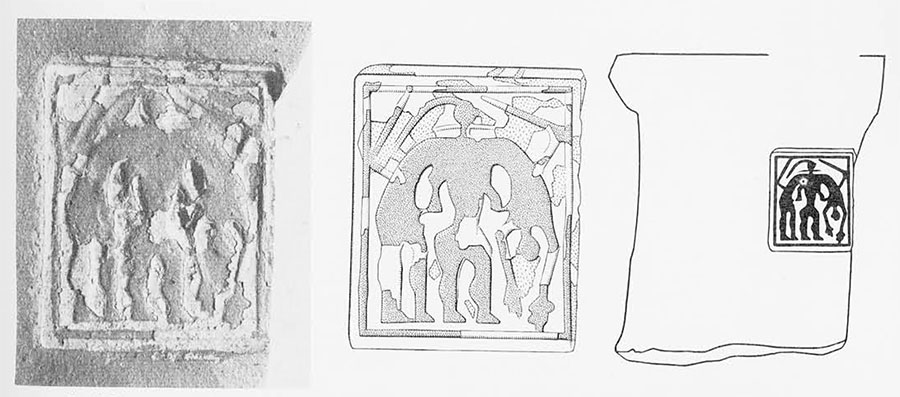
A remarkable piece of Geometric seal cutting of the end of the eighth century is shown in a drawing and a photograph. It is the impression of the device of a rectangular sealstone, on the neck of an unpainted amphora, showing a man carrying over his shoulders the dead body of a gigantic companion. The motif can be identified through representations on Attic vases of the sixth century inscribed with the names of the personages depicted, as Ajax carrying the body of Achilles from under the city walls of Troy to the Greek ships. The circumstance that impressions of the same sealstone had already been found on a votive terracotta plaque from the Hera sanctuary on the island of Samos, increases rather than diminishes the interest of this find. The death of Achilles is not described in the Iliad, but belongs to one of the poems of the so-called Epic Cycle, which were designed to fill in those aspects of the Trojan adventure not described in the Iliad or Odyssey. Only a few fragments of these poems survive, mostly believed to be the work of late epigones. Our sealstone impression demonstrates that at least the song of Achilles’ death was in fact quite an old one.
Among the material of later periods we may mention here only a series of antefixes and other architectural terra cottas–i.e. decorative revetments of the wooden structures of Greek temples–dating from the seventh, sixth, fifth, and fourth centuries B.C.
Perhaps the most fascinating of the finds we recovered from the ancient rubbish dump on the acropolis of Pithekoussai is a fair quantity of iron slag, two bottoms of rough pots the insides of which are encrusted with iron slag–in other words they had been used as crucibles–, and several fragments of bellows-mouthpieces of terra cotta. We have here the unequivocal proof of the existence of iron foundries. Iron ore does not occur on the island, nor on the near mainland. In Italy it is found only in the metalliferous region of Tuscany and on the offshore island of Elba. Only from there could the Greeks of Pithekoussai have obtained the ore. The dump which contained the slag is not stratified, but fortunately enough we had already found in 1961 a single stray piece of iron slag in the necropolis, in the deepest layer containing only eighth century material, without any later intrusions.
Before anything about the archaeology if Ischia was known, T.J. Dunbabin–in his masterly book The Western Greeks (1948)–had already conjectured that trade, and particularly the interest in the metals of Etruria, might have been the principal reason for the founding of the oldest Greek colonies in the West, Pithekoussai and Cumae. More recently it has often been denied that trade played an important role in the founding of colonies, for which only land-hunger and over-population are supposed to have been the main motives. It is particularly strange that this theory was formulated with special reference to Pithekoussai and Cumae. If the Euboeans chose a little hilly island so far distant from the motherland to found their first settlement in the West, motives other than the establishment of an agricultural colony must have been pressing. The excavations have indeed fully confirmed that Dunbabin was right. There can be no doubt now that the Euboeans on Ischia sought the iron from Tuscany and that at least part of it was smelted on the island itself. In exchange they furnished the Etruscans with the luxury goods of the Oriental civilizations.
John Boardman has recently shown that the earliest and probably most important Greek trading post in the Eastern Mediterranean, Al Mina at the mouth of the river Orontes in North Syria, was mainly in the hands of the Euboeans. According to the evidence of the pottery, its foundation goes back to the end of the ninth or the beginning of the eighth century B.C., thus antedating the founding of Pithekoussai, which falls in the second half of the eighth century, say about 775 B.C. It is significant that a certain class of Euboean pottery has so far been found only at Eretria and Chalcis in Euboea, at Al Mina, and at Ischia. There can be little doubt that with the possession of the base of Al Mina in the East and that of Pithekoussai in the West, the Euboeans were, from about 775 to about 700 B.C., the masters of the trade between the Eastern Mediterranean and Central Italy.
